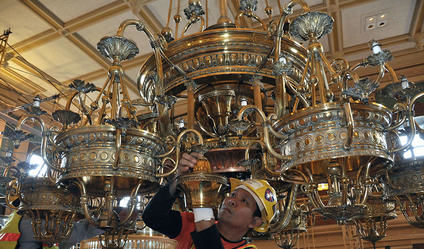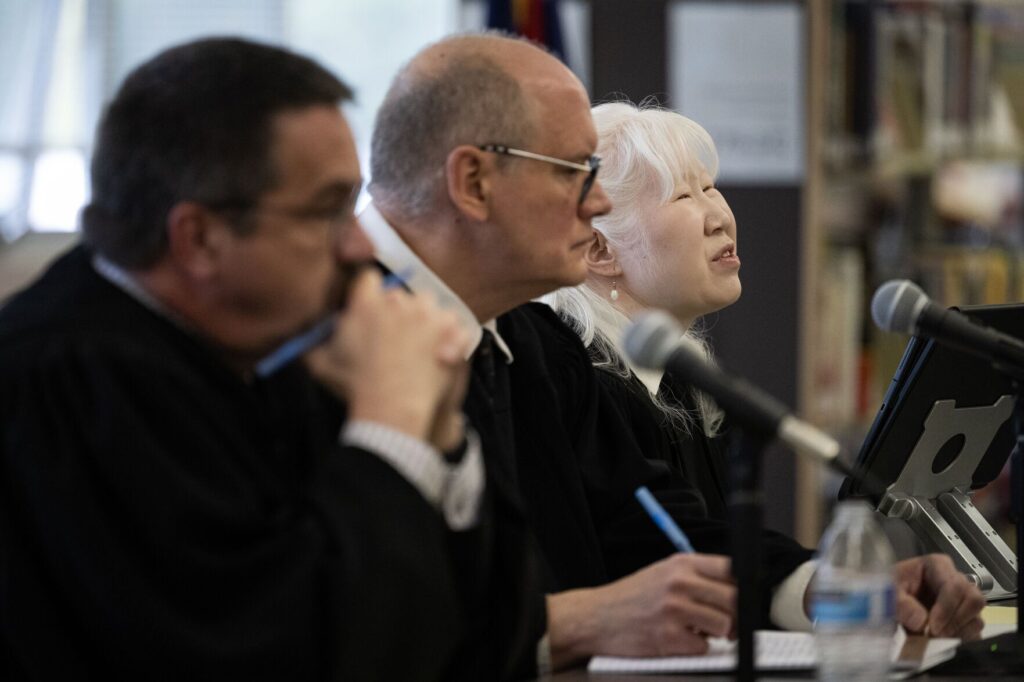Chandelier kicks off next phase of rehab

On Monday, contractors lowered the massive brass chandelier that hangs above the Colorado House of Representatives onto a platform and began taking it apart. It’s the start of the second phase of a three-year project designed to restore the legislative chambers to their historic appearance.
“We like to say we’re lowering it, not that we’re dropping it,” quipped Gary Behm, owner of St. Louis Antique Lighting Co., as assistants began dismantling the chandelier, which dates to the 1890s.
He plans to return the chandelier as near as possible to its original state — within reason, considering the Capitol was lit by gas in its early days — by removing high-wattage lamps that were added at one point, recreating a brass cage that surrounded it and restoring its shine. “It’ll have a lot of bling,” he said.
Behm’s company has done restoration work on lighting fixtures in 14 state capitols, the U.S. Capitol and the U.S. Supreme Court. Like most of the chandeliers from the period, the ones hanging in Colorado’s legislative chambers were likely crafted by Mitchell, Vance & Co., a New York-based company that was known as the primary supplier of what’s known as public-institution chandeliers between the Centennial in 1876 and the early 1900s.
“That’s when states had money to put into things,” Behm noted. “There’s a lot of complexity in design work in all these buildings.”
This phase of the $6 million project includes removing 1950s-era acoustic tile from the ceilings of both the House and Senate chambers, replacing it with classical stenciling like the decorations that adorn the walls of the chambers following the first stage of the restoration last summer and fall. The tiles also cover skylights above the chambers, which will be exposed. Contractors plan to hoist the House chandelier back in place in November.
Until work concludes this fall, the chambers will be hard-hat areas and closed to visitors.
The Senate’s chandelier is set for its own restoration next year in the third and final phase of the project. When crews have finished, both chandeliers will hang several feet lower, with a brass cage that had originally surrounded the top stretch of cable recreated by the antique lighting company.
While the Capitol was built and furnished in the late 1880s and early 1890s, the project aims to restore the chambers to their state in 1905, because there aren’t good records to guide restoration to a period before that.
That’s one reason that crews are “aggressively documenting” this project, said Doug Platt, communications manager for the Colorado Department of Personnel and Administration. A film crew recorded workers as they unscrewed shades and examined fittings on the chandelier. Platt noted that “2015” would be stamped on materials fixed in place during this year’s project, to help guide future generations of preservationists.
“We have to go back and reinvent the process and decision-making, the materials, from what we know,” Platt added. “So, in the future, when they go back to see what we did, there will be a record of the decisions, what the materials are.”
And it’s also why mysterious paintings on the House and Senate walls will remain hidden from view, although restoration experts have some notion of what lies beneath the surface.
When crews removed the acoustic tiles from the chambers’ walls last year, they revealed long-forgotten surfaces — green in the House and red in the Senate, following color scheme of the British House of Commons and House of Lords, legend has it — but after the walls had been visible for months, the discerning eye of a contractor detected images under the painted and stenciled surfaces.
“For six months, it was exposed and nobody saw it,” recalled Marilyn Eddins, the chief clerk of the House. But Patrick Tague, of Spectrum General Contractors, could make out faint differences in the texture, suggesting that the walls had earlier displayed designs and portraits. The insight was verified by infrared cameras and subsequent digital enhancement provided by the Denver Art Museum.
There’s a shield, a shield and an eagle, a Greek face and, on the back wall of the Senate, a portrait of Abraham Lincoln. (There’s another portrait on the same set of walls, but the glue daubs securing the acoustic tile obscure the eyes, so it’s impossible to tell who was portrayed there.)
Restoration experts briefly considered taking the paint down one more layer but, because there was no information about what had originally been on the walls, decided to stick with the 1905 target, after first documenting the buried images.
Describing the restoration project, Eddins, who has worked at the Capitol for more than 30 years, struggled to hold back tears.“It is emotional to me. This Capitol is emotional to me. I love it,” she said. “I get choked up. It’s just so amazing, and I’m lucky to be a part of it.”
It all began with a crooked radiator, she recalled with a smile.
Back in 2012, then-Speaker Frank McNulty had been asking for some time whether anyone could straighten the thing, she said. “For some reason, it was difficult to do with the piping, without tearing the wall apart, so he decided, ‘Let’s see what we can do, and, while we’re at it, let’s see what’s behind the tiles.’” That’s what led to the discovery of the stenciling and the decision to take down the tiles, she said.
By the time the potential project began to take shape the following year, Mark Ferrandino was House speaker. He got the Senate involved so that both chambers could be restored at once.
“You want to go historical, but you have to stay functional,” she said. Experts try to restore historic buildings and artifacts to their original condition but use modern technology where it’s appropriate, such as installing energy-efficient LED bulbs in the chandeliers.
There are plenty of modern additions to the House chambers that won’t be repealed, she said with a smile. Years ago, the desks were raised several inches to accommodate larger lawmakers, electricity was piped into the desks at some point and electronic voting was added in the 1970s. The current carpeting was installed in the 1980s and appears to be holding up well, she added.
The late-20th Century drinking fountain along the back wall of the House chambers is likely to stay put, for instance, although crews plan to install old water fountains — marble with brass spouts — in the Senate chambers.
Platt said he was hopeful that the chambers won’t have to be restored again for another 60 or so years.
“If we do our job right, this’ll be the one and only time we get to do this,” he said. “This is once in our lifetime.”












